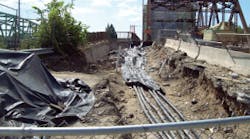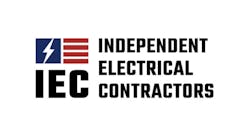Last year, a Philadelphia jury found eight manufacturers liable for the asbestos-related death of former Navy electrician’s mate, David Lanpher. During his 20-year career as an electrician’s mate, Lanpher worked in the engineering spaces of several ships, which required him to handle various engine parts and components, including asbestos-containing insulating boards and motor control units. In a video deposition, Lanpher recounted cutting and filing parts (including asbestos-containing motor control units) and regularly inhaling the dust caused by that work. After an honorable discharge in 1973, Lanpher worked as an electrician in Phoenix until August 2007 — when he became too ill to work and was diagnosed with malignant pleural mesothelioma. Lanpher died on July 13, 2008.
During the trial, according to Lanpher’s attorneys Waters & Kraus, Dallas, a defense expert testified that tests he conducted on the components demonstrated that the asbestos contained in the subassembly was encapsulated in a material that could not be breached in the way Lanpher described. However, the jury disagreed, finding the manufacturers both negligent and strictly liable for failure to warn of the inherent dangers of their products. Evidence showed that the manufacturer had known of the dangers of asbestos in the 1960s, but that the company’s executives considered its products safe, despite never having tested them.
Lanpher’s case isn’t the only one that has been brought to court in recent years. In 2006, an Ohio appeals court ruled that General Motors knew an electrician who worked as a contractor doing repairs from 1953 to 1990 was in danger from asbestos in the insulation on steam pipes and in wiring. In 2007, the family of a California electrician and construction subcontractor who died from mesothelioma settled with six defendants for $2.3 million before their wrongful death case went to trial. The defendants were accused of failing to warn the plaintiff about the hazards associated with asbestos exposure and not protecting him from that exposure. He had worked for more than 40 years as an electrician and subcontractor before his death in 2005.
Through work in operations and maintenance, as well as renovation projects in buildings constructed before 1980, electricians are among those at high risk for asbestos exposure (see Warning: May Contain Asbestos), which can cause cancer of the lung or gastrointestinal system, as well as mesothelioma, which affects the membranes covering the lungs in its most common form — pleural mesothelioma — or other body organs in its rarer forms.
From 1990 to 1999, according to asbestos.com, the construction industry was the most frequently listed occupation (24%) on U.S. death certificates of persons 15 years of age and older where asbestosis was listed as the cause of death. Of those, 4.4% listed “electrician” or “former electrician” as their vocation. In addition, a 1995 British study revealed building workers, including electricians, to be at the greatest risk of contracting mesothelioma. However, diseases associated with asbestos exposure generally do not present themselves until decades after the initial exposure. Therefore, electricians who may have been exposed to asbestos while working maintenance or renovation jobs may not exhibit symptoms for some time.
In the air
The most common hazards on renovation jobs, according to OSHA, are fall injuries, electrocution, caught-in and struck-by hazards, and exposure to overhead objects, confined spaces, and airborne contaminants, such as dust, asbestos, and silica. There also may be issues involving stabilization when load-bearing walls and supports are being repaired, altered, or removed. Regarding electrical renovations in particular, asbestos has been used in the past for electrical raceways and for insulation material in high-temperature applications, such as conductor insulation and arc chutes in circuit breakers and disconnect devices.
Additionally, renovation work sites may contain potentially hazardous materials not regulated by OSHA. For example, polychlorinated biphenyls (PCBs), which may be found in transformers, oil circuit breakers, capacitors, lead cables, and lighting fixture ballasts, are regulated instead by the EPA.
“If the ballasts have PCBs in them, they have to be sent to the proper facility — a hazardous disposal site,” says Bill Hines, service manager for Enterprise Electric, Boise, Idaho.
In addition, compact fluorescent lighting (CFL) lamps containing mercury have to be disposed of at a properly listed facility. “That’s a big liability on our side,” Hines continues. “We have to make sure that’s done correctly because the EPA can come back on you if you don’t.”
In addition, if lamps containing mercury break, contractors must follow the proper procedure for cleanup. “It’s OK if you have one or two lamps break,” says Hines. “Hazardous cleanup is only required for a ‘large quantity.’ But go ahead and ask me what that number is. Nobody will tell me. I suppose if you had a couple hundred lamps and they all broke at the same time, then you’ve got a problem.”
In any quantity, the site should be cleaned using a shop vacuum equipped with a high-efficiency particulate air (HEPA) filter and sealed container, according to the EPA. Procedures also need to be in place for safely emptying that container and disposing of the resulting hazardous waste.
To prevent any incidents on his job sites, Hines orders his lamps in small quantities with proper containers. “I did a lot of homework before we started lighting retrofits, because we were going to be handling a large quantity of lamps. We engineered that problem away by simply handling them in small quantities with proper containers.”
Although not used in paints manufactured after 1978, lead still can be found in old faucets, plumbing pipes, solder, and walls painted before 1978 (see EPA Requires Certified Renovators for Lead-Safe Practices). Even in small amounts, the substance can cause high blood pressure and reproductive/kidney problems in adults.
Other materials aren’t regulated by either organization but can still be found on the job site. Volatile organic compounds (VOCs), such as formaldehyde, benzene, and xylene, are emitted from carpeting, caulk, cleaners, glues, paints, plastics, pressed wood products, and stains. These are noxious chemicals that can trigger headaches, dizziness, nausea, chronic respiratory problems and increased cancer risk. Arsenic, a carcinogenic heavy metal known to cause conditions ranging from contact dermatitis to kidney damage, can be found in pressure-treated wood preserved with chromated copper arsenate (CCA), which was used before 2004 to construct residential decks and foundations. Fiberglass can irritate the skin, eyes, nose, and throat; however, there is no current consensus on its long-term health effects.
“Certainly, when working in older buildings, you can still encounter those materials,” says Frank Westfall, VP of the Health, Safety and Environmental Services Unit of ESIS, which provides environmental training. “There’s potentially still a hazard when you’re doing either a retrofit of a building or maintenance. These are still exposures that exist.”
However, many electrical workers seem unaware of the danger of exposure, according to Westfall. In training sessions for clients with in-house electricians, it became clear that many workers considered asbestos, in particular, to be a problem of the past. “It’s interesting for our trainers and for me as well to hear the stories in the field,” says Westfall, who explains many electrical workers think asbestos isn’t used anymore or that it has been removed from buildings. “That is not the case. When you’re looking at older buildings and older construction, it is still is a hazard that electricians are dealing with — not only in the building environment, but also in the utility corridors.”
This, says Westfall, is due to the aging building stock in the country. In 2009, a survey by SMR Research Corp., Hackettstown, N.J., revealed that nationally, the average age of U.S. commercial buildings was 41.7 years. Of the 4.61 million buildings studied, 14.3% were built within the last 10 years, and 15% were more than 75 years old. “Much of the electrical wiring was put in during the ’40s, ’50s, and ’60s, and that was sheathed in or encased in asbestos cement board,” Westfall explains. “We probably get two or three calls a month to come out to a site to work with a contractor or an electrician on what they’ve dug up that appears to be asbestos. While that’s fairly well understood now by the construction industry, it’s not managed very well in the field from the standpoint of ‘Do you know what you’re going to impact before you dig? Do you know what’s in your manhole, in the utility corridors?’ Really, recognition and awareness of what you can run into is the most important factor when you’re looking in the field and at field operations.”
Safety in communication
Through awareness and communication, Westfall maintains that hazards can be managed. “Those incidents can certainly be managed with training and with communication among building owner to contractor to subcontractor,” he says.
In the training courses, his staff receives questions from subcontractors, including electricians who may think that a hazard is merely dust or debris. “It’s something they don’t recognize, but the smell is overpowering and the guys won’t work in there,” Westfall says. “A smarter way to do it is to recognize it and know whom to contact so the work isn’t impacted — and they’re not exposing either their supervisor or on-site employees.”
Westfall encourages job-site safety analysis and toolbox safety meetings. “Talk about the environmental hazards,” he says. “If you’re going into a five-story building that’s been vacant for 20 years — and you’re looking at possible exposures — speak to the fact that you may know if the building has asbestos in it. Then say we’re not going into the following areas; we know we have lead paint here, so we have a contractor to manage that for us. Speak to these things before you start the work — exactly where the hazards are so you can avoid exposure.”
In addition, Westfall cites OSHA’s standard 1910.1200, which makes the building owner responsible for communicating the hazards within its property to the contractor. Then, the contractor is responsible to communicate those hazards to the subcontractors. “OSHA speaks to the fact that, as a contractor, you need to inform your employees of potential hazards of materials — not only the material they’re working with, but also in the environments where they do their work,” he notes.
Owners, contractors, and subcontractors should also fill out and share manufacturer safety data sheets (MSDS). “On many projects, the electrician is the subcontractor to a much bigger general contractor, so what we stress in our training is to communicate the hazards, whether it’s asbestos in ceilings or walls, PCBs in older ballasts, or mercury in light tubes,” says Westfall. “Be aware of how these things are going to be managed. What happens if you find a leaking ballast? How do you go about reporting that up through the chain of command before you touch it and are unnecessarily exposed in the field? That’s the approach we take. I’d rather be proactive and see everybody come home without being exposed to anything than have them go out and have a lot of questions about what the building they’re working in contains.”
The chain of command, according to Westfall, is first your supervisor, followed by the general contractor’s designated safety professional. Nevertheless, the building owner is supposed to be the most knowledgeable source of how the building is constructed as well as what is in it. Westfall says it’s helpful to ask questions, “‘Do you still have PCB-containing transformers in that building, and you’re asking us to work on those? Do you have asbestos? Are there mercury switches we’re going to be pulling out when we do our electrical work? How would you like us to deal with those things?’ You look for the designated safety supervisor for the site. If there’s not one on your job, talk to your supervisor. Have them talk to the home office in order to talk to the building owner directly. That’s the communication tack that we encourage.”
Earlier this year, Enterprise Electric worked on a project in a federal building that contained asbestos. “Basically, you’re notified of it,” says Hines. “You’re notified of what procedures to do and when; then you just follow those guidelines.”
Although Hines took a voluntary asbestos identification class, his firm prefers not to deal with hazards removal. “If we see something that resembles asbestos, we’re supposed to stop and have somebody check it, and get authorization that it is or is not asbestos,” he explains. “Then the owner will do testing and analysis. If there is a hazard, then typically they’ll just clean it up. If it’s still in there, you can’t open a ceiling tile until a competent person has opened the ceiling with protective equipment on and tested the particulates up there. Then they tell you if you can go in or not — that’s something we do not choose to go into.”
SIDEBAR: Warning: May Contain Asbestos
Electrical products no longer contain asbestos. However, many electricians work on the maintenance and renovation of equipment and buildings that contain material installed before 1980. Therefore, those workers must protect themselves from items containing the hazardous substance. According to asbestos.com, asbestos-containing items encountered by electricians may include:
- Acoustical plaster
- Ceiling tiles
- Cement siding
- Cement wallboard
- Decorative plaster
- Electrical cloth
- Electrical ducts
- Electrical panel partitions
- Electric wiring insulation
- High-temperature gaskets
- Housings for motors, transformers, generators, and electronic controllers
- Spackling compounds
- Textured paints
- Thermal paper products
SIDEBAR: EPA Requires Certified Renovators for Lead-Safe Practices
Common renovation activities, such as sanding, cutting, and demolition, can create hazardous lead dust and chips by disturbing lead-based paint, which can be harmful to adults and children, according to the U.S. Environmental Protection Agency (EPA). Since April 22, 2010, the EPA requires contractors performing renovation, repair, and painting projects that disturb lead-based paint in homes, childcare facilities, and schools built before 1978 to be certified and follow specific work practices to prevent lead contamination. Individuals can become certified renovators by taking an 8-hour training course from an EPA-approved training provider.
Contractors must use lead-safe work practices and follow these three simple procedures:
- Contain the work area.
- Minimize dust.
- Clean up thoroughly.
The rule affects paid renovators who work in pre-1978 housing and child-occupied facilities, including:
- Renovation contractors
- Maintenance workers in multi-family housing
- Painters and other specialty trades
Under the rule, child-occupied facilities are defined as residential, public, or commercial buildings where children under age six are present on a regular basis. The requirements apply to renovation, repair, or painting activities. The rule generally does not apply to minor maintenance or repair activities where less than 6 square feet of lead-based paint is disturbed in a room or where less than 20 square feet of lead-based paint is disturbed on the exterior (not including window replacement, demolition, or prohibited practices).



